

PubPeer - Search publications and join the conversation. Peer Review and Golden Chopsticks. Physics Education - (Phil extended footage) L’organisation d’un débat public sur des questions scientifiques ou techniques est impossible. A cause d'eux. Ils ont remporté une victoire importante en contraignant les organisateurs des derniers débats publics sur des questions scientifiques à se réfugier sur Internet.
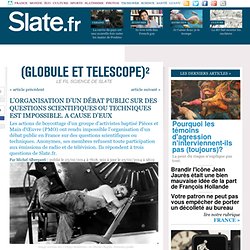
Plus aucune réunion publique sur les nanotechnologies ou l’enfouissement des déchets nucléaires ne peut se tenir en France sans être perturbées. GtR. Pour une meilleure visibilité de la recherche française 2/3 : Gestion des informations tout au long du cycle de vie de la recherche. Dans le premier volet de notre enquête sur le manque de visibilité et de lisibilité de la recherche française, nous avons mis en lumière l’absence de données permettant de repérer les projets de recherche en cours et de suivre le chemin précis menant des financements aux résultats.
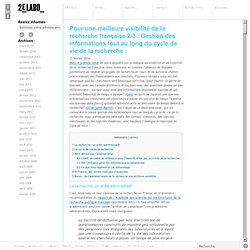
How GIFs are changing the way we talk science. The use of “GIFs” has exploded in recent years.
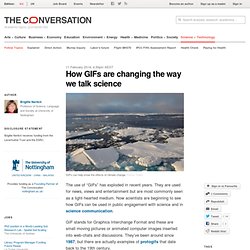
They are used for news, views and entertainment but are most commonly seen as a light-hearted medium. Now scientists are beginning to see how GIFs can be used in public engagement with science and in science communication. Crowdfunding Platform for Science Research Grants. The greatest newspaper correction ever written (49 years too late) Fraud in the Ivory Tower. Tilburg University professor Diederik Stapel was something of a star in the field of social psychology.

His research on human behavior had achieved renown both in the Netherlands and abroad. Schekman's 'luxury journal' boycott doesn't go far enough. Recipients of this year’s Nobel Prizes converged on Stockholm to receive their medals, dine with the King and Queen, and be treated like the scientific royalty.
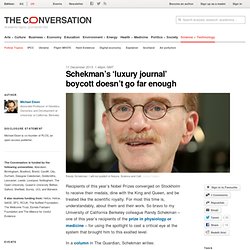
For most this time is, understandably, about them and their work. So bravo to my University of California Berkeley colleague Randy Schekman – one of this year’s recipients of the prize in physiology or medicine – for using the spotlight to cast a critical eye at the system that brought him to this exalted level. In a column in The Guardian, Schekman writes: Journals and researchers must respond to Schekman's move. Having climbed all the way to the Nobel Prize on a ladder made of papers published in Nature, Science and Cell, biologist Randy Schekman has declared that he is now going to boycott these luxury journals because he believes they damage science.
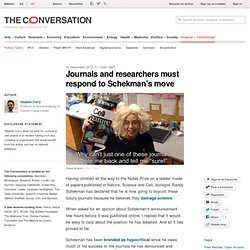
When asked for an opinion about Schekman’s announcement few hours before it was published online, I replied that it would be easy to carp about the position he has adopted. And so it has proved to be. Schekman has been branded as hypocritical since he owes much of his success to the journals he has denounced and because, in his tenure as editor at PNAS (Proceedings of the National Academy of Sciences), another prestigious journal, he exhibited many of the foibles that he finds in the editors at Nature, Science and Cell. Flawed sting operation singles out open access journals. In a sting operation, John Bohannon, a correspondent of Science, claims to have exposed dodgy open access journals.

His argument seems to be that, because of their business model, some journals are biased towards accepting scientific articles, regardless of their quality. Sadly, Bohannon’s operation adds little to what we already know. The Rise of Open Access. Scientific Discourse: Buckling at the Seams. Thomas Edison built an empire on his 1093 patents.
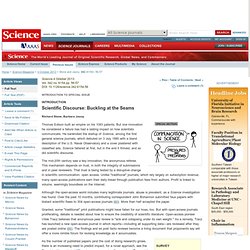
But one innovation he considered a failure has had a lasting impact on how scientists communicate. He bankrolled the startup of Science, among the first general science journals, which debuted on 3 July 1880 with a bland description of the U.S. Naval Observatory and a cover plastered with classified ads. Science faltered at first, but in the end it thrived, and so did scientific discourse. The mid-20th century saw a key innovation, the anonymous referee.
Who's Afraid of Peer Review? A spoof paper concocted by Science reveals little or no scrutiny at many open-access journals.
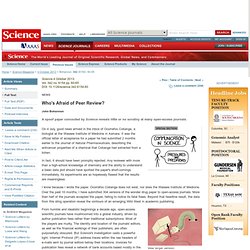
On 4 July, good news arrived in the inbox of Ocorrafoo Cobange, a biologist at the Wassee Institute of Medicine in Asmara. It was the official letter of acceptance for a paper he had submitted 2 months earlier to the Journal of Natural Pharmaceuticals, describing the anticancer properties of a chemical that Cobange had extracted from a lichen. In fact, it should have been promptly rejected. Any reviewer with more than a high-school knowledge of chemistry and the ability to understand a basic data plot should have spotted the paper's short-comings immediately. Its experiments are so hopelessly flawed that the results are meaningless.
I know because I wrote the paper. Who's Afraid of Peer Review? Science invente un faux chercheur et berne les pseudo-revues scientifiques. Biologist lets new Curiosity rover papers escape from paywall. Yesterday's edition of Science included four papers that describe some of the most detailed results yet available on the rock and soil analyses performed by the Curiosity Mars rover.
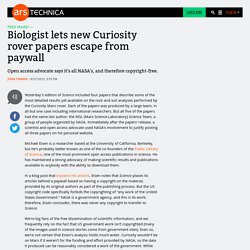
Each of the papers was produced by a large team, in all but one case including international researchers. But all five of the papers had the same last author: the MSL (Mars Science Laboratory) Science Team, a group of people organized by NASA. NASA paywalls first papers arising from Curiosity rover, I am setting them free. The Mars Curiosity rover has been a huge boon for NASA – tapping into the public’s fascination with space exploration and the search for life on other planets. Its landing was watched live by millions of people, and interest in the photos and videos it is collecting is so great, that NASA has had to relocate its servers to deal with the capacity.
So what does NASA do to reward this outpouring of public interest (not to mention to $2.5 billion taxpayer dollars that made it possible)? They publish the first papers to arise from the project behind a Science magazine’s paywall: There’s really no excuse for this. The people in charge of the rover project clearly know that the public are intensely interested in everything they do and find. This whole situation is even more absurd, because US copyright law explicitly says that all works of the federal government – of which these surely must be included – are not subject to copyright.
Slick Data Visualization Reveals Scientific Collaborations Taking Place Around the Globe. A few years ago, digital humanists at Stanford mapped the Republic of Letters, carefully detailing the social networks that connected thinkers during the Enlightenment of the eighteenth century. Now Olivier Beauchesne, a data scientist in Canada, has used data visualization techniques to map out a more modern set of relationships – collaborations taking place among scientists across the globe. Why Has the Number of Scientific Retractions Increased?
Nobel laureate occasionally hangs out on street corners, answering physics questions. Richard Feynman Computer Heuristics Lecture.
Autistic teenager tipped for Nobel Prize. Nature makes an effort to enhance reproducibility in science. Sketches of Science – Nobel Pictures - Lindau Nobel Online Community. Three years ago I met the photographer Volker Steger for the first time. He prepared one of the ‚secret’ rooms in the Inselhalle in Lindau. Huge white sheets of paper and wax crayons lay around. You would not have guessed, that what happend there, was high art with simple means. It was the 60ths Nobel Laureate Meeting which due to the 50th anniversary and interdisciplinarity of the meeting was attended by 59 Nobel Laureates. Crowdfunding in Science? A conversation with Jai Ranganathan.
"Just a Theory": 7 Misused Science Words. Hypothesis. Theory. Law. These scientific words get bandied about regularly, yet the general public usually gets their meaning wrong. Now, one scientist is arguing that people should do away with these misunderstood words altogether and replace them with the word "model. " But those aren't the only science words that cause trouble, and simply replacing the words with others will just lead to new, widely misunderstood terms, several other scientists said.
Climate change flow chart: How to win any global warming argument. If you’re exhausted by climate change shouting matches or so flummoxed by confronting scientific ignorance that you suffer in silence, this chart might be for you. It provides responses to three of the common stages of climate change disbelief: that climate change isn’t happening, that scientists can’t decide whether it’s happening, and that it’s happening but not caused by mankind. Will this chart prevent your debates from devolving into fights over the “liberal climate change conspiracy” and the meaning of the words theory or climate or change? There’s only one way to find out. This story was produced as part of the Climate Desk collaboration.
Richard Feynman - Ode To A Flower. Richard Feynman on God. Richard Feynman Electricity. Using physics to explain how the world works (1983) Feynman on Scientific Method. Albert Einstein- How I See the World. The Great Debate: THE STORYTELLING OF SCIENCE (OFFICIAL) - (Part 1/2) The Great Debate: THE STORYTELLING OF SCIENCE (OFFICIAL) - (Part 2/2) Top 10 des manières subtiles de signifier à votre entourage que vous êtes chercheur. Le statut de "chercheur" est un titre prestigieux. Mal payé certes, mais prestigieux. Le problème, c'est que vous ne pouvez pas décemment écrire sur votre front "cerveau au travail" ou coller un sticker "savant à bord" à l'arrière de votre bagnole. Et une blouse blanche pourrait vous faire passer pour un secrétaire médical ou un prothésiste dentaire. ENCODE et la vulgarisation scientifique.
Mathematicians aim to take publishers out of publishing. Jean-Pierre Demailly is a leader in an effort to create a researcher-run publishing system. Mathematicians plan to launch a series of free open-access journals that will host their peer-reviewed articles on the preprint server arXiv. The project was publicly revealed yesterday in a blog post by Tim Gowers, a Fields Medal winner and mathematician at the University of Cambridge, UK.
The initiative, called the Episciences Project, hopes to show that researchers can organize the peer review and publication of their work at minimal cost, without involving commercial publishers. Des anti-OGM repentis parlent. Why it is time to simply say "No" Dr. Jens Katzek As a former Friends of the Earth campaigner against genetically modified food, I finally left in the mids of the 90th after almost 10 years the environmental organization I previously worked for because of their opposition to Golden Rice. And the more I follow the most recent debates on Golden Rice the more I am still convinced that this was a very good decision. Pourquoi il est simplement temps de dire "Non" Je suis un ancien militant anti-OGM de Friends of the Earth et j’ai finalement quitté au milieu des années 90 cette organisation pour laquelle j’ai travaillé pendant près de 10 ans, en raison de son opposition au Riz Doré.
Open Access Explained! La justice a tranché, le CERN a le permis de tuer. Le Centre Européen pour la Recherche Nucléaire aka CERN porte bien son nom ... il fait peur. Tellement peur qu'une allemande a jugé bon de lui intenter un procès, comprenez, pour éviter la fin du monde et que nous soyons tous anéantis.
Les travaux du CERN sont presque expérimentaux, on ne sait pas vraiment ce qui pourrait sortir de leur laboratoire. A trop jouer avec les lois de l’univers, une allemande s’est dit que rien de bon ne pouvait sortir de ce centre. Pis, imaginez que les chercheurs réussissent à créer un mini trou-noir … Apocalypse, fin du monde, ‘toussa toussa’ et nous voilà tous tout absorbés. Dossier spécial : tout (ou presque) sur le CRIIGEN. La cause est entendue dans les médias et chez la plupart des journalistes français : -il n’existe qu’un organisme de recherche « indépendant » sur les OGM : le Comité de recherche et d’information « indépendantes » sur le génie génétique (les guillemets sont de moi) ou CRIIGEN. -Il n’existe qu’un expert en biotechnologies : Gilles-Eric Séralini. Nous avons régulièrement publié des articles pour tenter de démonter ces mythes, qui ont pourtant la vie dure.
Michael Nielsen: Open science now! The polymath blog. Polymath Project. The Polymath Project is a collaboration among mathematicians to solve important and difficult mathematical problems by coordinating many mathematicians to communicate with each other on finding the best route to the solution. The project began in January 2009 on Tim Gowers' blog when he posted a problem and asked his readers to post partial ideas and partial progress toward a solution. Comments on internet publications, what to do? Gilles-Eric Séralini, ou le cirque publicitaire. Should the Government Support Applied Research? Competitivite.gouv.fr/documents/commun/Documentation_poles/territoires-poles/TERRITOIRES-poles-03-06-2010.pdf. Competitivite.gouv.fr/documents/commun/Documentation_poles/cartes-poles/carte.pdf. Véhicule du Futur 06/15 > BE Etats-Unis 294 > L'avenir des grandes unversités est-il sur Internet ?
03/30 > BE Etats-Unis 284 > Entrevue avec le Dr Ashley Stevens : le transfert de technologies dans les universités américaines [partie 3/3] 5 Great Scientists Who Believed Wildly Unscientific Things. Les frères Bogdanov, terreur des chercheurs. 05/11 > BE Etats-Unis 289 > La Maison-Blanche fait la part belle à la bioéconomie.
05/11 > BE Etats-Unis 289 > Dépenses privées de R&D aux Etats-Unis : les secteurs en progression (partie 2/2)